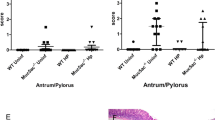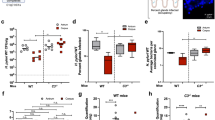Abstract
Cathelicidin, an antimicrobial peptide of the innate immune system, has been shown to modulate microbial growth, wound healing and inflammation. However, whether cathelicidin controls Helicobacter pylori infection in vivo remains unexplored. This study sought to elucidate the role of endogenous and exogenous mouse cathelicidin (CRAMP) in the protection against H. pylori infection and the associated gastritis in mice. Results showed that genetic ablation of CRAMP in mice significantly increased the susceptibility of H. pylori colonization and the associated gastritis as compared with the wild-type control. Furthermore, replenishment with exogenous CRAMP, delivered via a bioengineered CRAMP-secreting strain of Lactococcus lactis, reduced H. pylori density in the stomach as well as the associated inflammatory cell infiltration and cytokine production. Collectively, these findings indicate that cathelicidin protects against H. pylori infection and its associated gastritis in vivo. Our study also demonstrates the feasibility of using the transformed food-grade bacteria to deliver cathelicidin, which may have potential clinical applications in the treatment of H. pylori infection in humans.
This is a preview of subscription content, access via your institution
Access options
Subscribe to this journal
Receive 12 print issues and online access
$259.00 per year
only $21.58 per issue
Buy this article
- Purchase on Springer Link
- Instant access to full article PDF
Prices may be subject to local taxes which are calculated during checkout









Similar content being viewed by others
References
Warren JR, Marshall B.J . Unidentified curved bacilli on gastric epithelium in active chronic gastritis. Lancet 1983; 1: 1273–1275.
Everhart JE . Recent developments in the epidemiology of Helicobacter pylori. Gastroenterol Clin North Am 2000; 29: 559–578.
Cover TL, Blaser MJ . Helicobacter pylori infection, a paradigm for chronic mucosal inflammation: pathogenesis and implications for eradication and prevention. Adv Intern Med 1996; 41: 85–117.
Suerbaum S, Josenhans C . Helicobacter pylori evolution and phenotypic diversification in a changing host. Nat Rev Microbiol 2007; 5: 441–452.
Song MJ, Park DI, Park JH, Kim HJ, Cho YK, Sohn CI et al. The effect of probiotics and mucoprotective agents on PPI-based triple therapy for eradication of Helicobacter pylori. Helicobacter 2010; 15: 206–213.
Wu WK, Wong CC, Li ZJ, Zhang L, Ren SX, Cho CH . Cathelicidins in inflammation and tissue repair: potential therapeutic applications for gastrointestinal disorders. Acta Pharmacol Sin 2010; 31: 1118–1122.
Hase K, Murakami M, Iimura M, Cole SP, Horibe Y, Ohtake T et al. Expression of LL-37 by human gastric epithelial cells as a potential host defense mechanism against Helicobacter pylori. Gastroenterology 2003; 125: 1613–1625.
Iimura M, Gallo RL, Hase K, Miyamoto Y, Eckmann L, Kagnoff MF . Cathelicidin mediates innate intestinal defense against colonization with epithelial adherent bacterial pathogens. J Immunol 2005; 174: 4901–4907.
Lopez-Garcia B, Lee PH, Yamasaki K, Gallo RL . Anti-fungal activity of cathelicidins and their potential role in Candida albicans skin infection. J Invest Dermatol 2005; 125: 108–115.
Dorschner RA, Pestonjamasp VK, Tamakuwala S, Ohtake T, Rudisill J, Nizet V et al. Cutaneous injury induces the release of cathelicidin anti-microbial peptides active against group A Streptococcus. J Invest Dermatol 2001; 117: 91–97.
Yang YH, Wu WK, Tai EK, Wong HP, Lam EK, So WH et al. The cationic host defense peptide rCRAMP promotes gastric ulcer healing in rats. J Pharmacol Exp Ther 2006; 318: 547–554.
Tai EK, Wu WK, Wong HP, Lam EK, Yu L, Cho CH . A new role for cathelicidin in ulcerative colitis in mice. Exp Biol Med (Maywood) 2007; 232: 799–808.
Wong CC, Zhang L, Li ZJ, Wu WK, Ren SX, Chen YC et al. Protective effects of cathelicidin-encoding Lactococcus lactis in murine ulcerative colitis. J Gastroenterol Hepatol 2012; 27: 1205–1212.
Hu S, Kong J, Kong W, Ji M . Identification of nisin-producing strains by nisin-controlled gene expression system. Curr Microbiol 2009; 58: 604–608.
Zhou XX, Li WF, Ma GX, Pan YJ . The nisin-controlled gene expression system: construction, application and improvements. Biotechnol Adv 2006; 24: 285–295.
Mierau I, Kleerebezem M . 10 years of the nisin-controlled gene expression system (NICE) in Lactococcus lactis. Appl Microbiol Biotechnol 2005; 68: 705–717.
Mierau I, Olieman K, Mond J, Smid EJ . Optimization of the Lactococcus lactis nisin-controlled gene expression system NICE for industrial applications. Microb Cell Fact 2005; 4: 16.
Bermudez-Humaran LG . Lactococcus lactis as a live vector for mucosal delivery of therapeutic proteins. Hum Vaccin 2009; 5: 264–267.
Lee A, O'Rourke J, De Ungria MC, Robertson B, Daskalopoulos G, Dixon MF . A standardized mouse model of Helicobacter pylori infection: introducing the Sydney strain. Gastroenterology 1997; 112: 1386–1397.
Atherton JC . H. pylori virulence factors. Br Med Bull 1998; 54: 105–120.
Thompson LJ, Danon SJ, Wilson JE, O'Rourke JL, Salama NR, Falkow S et al. Chronic Helicobacter pylori infection with Sydney strain 1 and a newly identified mouse-adapted strain (Sydney strain 2000) in C57BL/6 and BALB/c mice. Infect Immun 2004; 72: 4668–4679.
Kim YH, Lee JH, Lee SS, Cho EY, Oh YL, Son HJ et al. Long-term stress and Helicobacter pylori infection independently induce gastric mucosal lesions in C57BL/6 mice. Scand J Gastroenterol 2002; 37: 1259–1264.
Ohtani M, Garcia A, Rogers AB, Ge Z, Taylor NS, Xu S et al. Protective role of 17 beta -estradiol against the development of Helicobacter pylori-induced gastric cancer in INS-GAS mice. Carcinogenesis 2007; 28: 2597–2604.
Chromek M, Slamova Z, Bergman P, Kovacs L, Podracka L, Ehren I et al. The antimicrobial peptide cathelicidin protects the urinary tract against invasive bacterial infection. Nat Med 2006; 12: 636–641.
Fox GE, Magrum LJ, Balch WE, Wolfe RS, Woese CR . Classification of methanogenic bacteria by 16S ribosomal RNA characterization. Proc Natl Acad Sci USA 1977; 74: 4537–4541.
Gupta R, Lanter JM, Woese CR . Sequence of the 16S ribosomal RNA from Halobacterium volcanii, an Archaebacterium. Science 1983; 221: 656–659.
Byfield FJ, Kowalski M, Cruz K, Leszczynska K, Namiot A, Savage PB et al. Cathelicidin LL-37 increases lung epithelial cell stiffness, decreases transepithelial permeability, and prevents epithelial invasion by Pseudomonas aeruginosa. J Immunol 187: 6402–6409.
Nizet V, Ohtake T, Lauth X, Trowbridge J, Rudisill J, Dorschner RA et al. Innate antimicrobial peptide protects the skin from invasive bacterial infection. Nature 2001; 414: 454–457.
Bonacorsi C, Raddi MS, da Fonseca LM, Sannomiya M, Vilegas W . Effect of Byrsonima crassa and phenolic constituents on Helicobacter pylori-induced neutrophils oxidative burst. Int J Mol Sci 2012; 13: 133–141.
Kaparakis M, Walduck AK, Price JD, Pedersen JS, van Rooijen N, Pearse MJ et al. Macrophages are mediators of gastritis in acute Helicobacter pylori infection in C57BL/6 mice. Infect Immun 2008; 76: 2235–2239.
Saito A, Yokohama A, Osaki Y, Ogawa Y, Nakahashi H, Toyama K et al. Circulating plasmacytoid dendritic cells in patients with primary and Helicobacter pylori-associated immune thrombocytopenia. Eur J Haematol 2012; 88: 340–349.
Nagy TA, Allen SS, Wroblewski LE, Flaherty DK, Slaughter JC, Perez-Perez G et al. Helicobacter pylori induction of eosinophil migration is mediated by the cag pathogenicity island via microbial-epithelial interactions. Am J Pathol 2012; 178: 1448–1452.
Konturek JW . Discovery by Jaworski of Helicobacter pylori and its pathogenetic role in peptic ulcer, gastritis and gastric cancer. J Physiol Pharmacol 2003; 54 (Suppl 3): 23–41.
Takahashi S, Nakamura E, Okabe S . Effects of cytokines, without and with Helicobacter pylori components, on mucus secretion by cultured gastric epithelial cells. Dig Dis Sci 1998; 43: 2301–2308.
Amieva MR, El-Omar EM . Host-bacterial interactions in Helicobacter pylori infection. Gastroenterology 2008; 134: 306–323.
Yamaoka Y, Kita M, Kodama T, Sawai N, Imanishi J . Helicobacter pylori cagA gene and expression of cytokine messenger RNA in gastric mucosa. Gastroenterology 1996; 110: 1744–1752.
Mannam P, Jones KF, Geller BL . Mucosal vaccine made from live, recombinant Lactococcus lactis protects mice against pharyngeal infection with Streptococcus pyogenes. Infect Immun 2004; 72: 3444–3450.
Ravnikar M, Strukelj B, Obermajer N, Lunder M, Berlec A . Engineered lactic acid bacterium Lactococcus lactis capable of binding antibodies and tumor necrosis factor alpha. Appl Environ Microbiol 2010; 76: 6928–6932.
Watson D, Sleator RD, Hill C, Gahan CG . Enhancing bile tolerance improves survival and persistence of Bifidobacterium and Lactococcus in the murine gastrointestinal tract. BMC Microbiol 2008; 8: 176.
Gotteland M, Brunser O, Cruchet S . Systematic review: are probiotics useful in controlling gastric colonization by Helicobacter pylori? Aliment Pharmacol Ther 2006; 23: 1077–1086.
Tai EK, Wu WK, Wang XJ, Wong HP, Yu L, Li ZJ et al. Intrarectal administration of mCRAMP-encoding plasmid reverses exacerbated colitis in Cnlp(−/−) mice. Gene Ther 2012.
Holo H, Nes IF . High-frequency transformation, by electroporation, of Lactococcus lactis subsp. cremoris grown with glycine in osmotically stabilized media. Appl Environ Microbiol 1989; 55: 3119–3123.
McGuckin MA, Every AL, Skene CD, Linden SK, Chionh YT, Swierczak A et al. Muc1 mucin limits both Helicobacter pylori colonization of the murine gastric mucosa and associated gastritis. Gastroenterology 2007; 133: 1210–1218.
Roussel Y, Wilks M, Harris A, Mein C, Tabaqchali S . Evaluation of DNA extraction methods from mouse stomachs for the quantification of H. pylori by real-time PCR. J Microbiol Methods 2005; 62: 71–81.
De R, Kundu P, Swarnakar S, Ramamurthy T, Chowdhury A, Nair GB et al. Antimicrobial activity of curcumin against Helicobacter pylori isolates from India and during infections in mice. Antimicrob Agents Chemother 2009; 53: 1592–1597.
Stoffel MH, Friess AE, Burnens A, Schmassmann A, Neiger R . Distinction of gastric Helicobacter spp. in humans and domestic pets by scanning electron microscopy. Helicobacter 2000; 5: 232–239.
Bals R, Wang X, Zasloff M, Wilson JM . The peptide antibiotic LL-37/hCAP-18 is expressed in epithelia of the human lung where it has broad antimicrobial activity at the airway surface. Proc Natl Acad Sci USA 1998; 95: 9541–9546.
Sgouras D, Maragkoudakis P, Petraki K, Martinez-Gonzalez B, Eriotou E, Michopoulos S et al. In vitro and in vivo inhibition of Helicobacter pylori by Lactobacillus casei strain Shirota. Appl Environ Microbiol 2004; 70: 518–526.
Acknowledgements
This work was supported by the Research Fund for the Control of Infectious Diseases 08070402 from the Food and Health Bureau of Hong Kong. We also thank Ms Jean KUNG and Ms Corinna AU (School of Biomedical Sciences, The Chinese University of Hong Kong) for their technical assistance to perform immunohistochemistry and SEM; Dr Ming-hua Li (Shenzhen Nanshan Hospital) for his professional advice on the pathology of stomachs; and Mr Siu Hong Eagle CHU (Institute of Digestive Diseases, The Chinese University of Hong Kong) for his help on animal study.
Author information
Authors and Affiliations
Corresponding authors
Ethics declarations
Competing interests
The authors declare no conflict of interest.
Rights and permissions
About this article
Cite this article
Zhang, L., Yu, J., Wong, C. et al. Cathelicidin protects against Helicobacter pylori colonization and the associated gastritis in mice. Gene Ther 20, 751–760 (2013). https://doi.org/10.1038/gt.2012.92
Received:
Revised:
Accepted:
Published:
Issue Date:
DOI: https://doi.org/10.1038/gt.2012.92
Keywords
This article is cited by
-
LncRNA RP11-93B14.5 promotes gastric cancer cell growth through PI3K/AKT signaling pathway
Molecular Biotechnology (2023)
-
Cathelicidin preserves intestinal barrier function in polymicrobial sepsis
Critical Care (2020)



